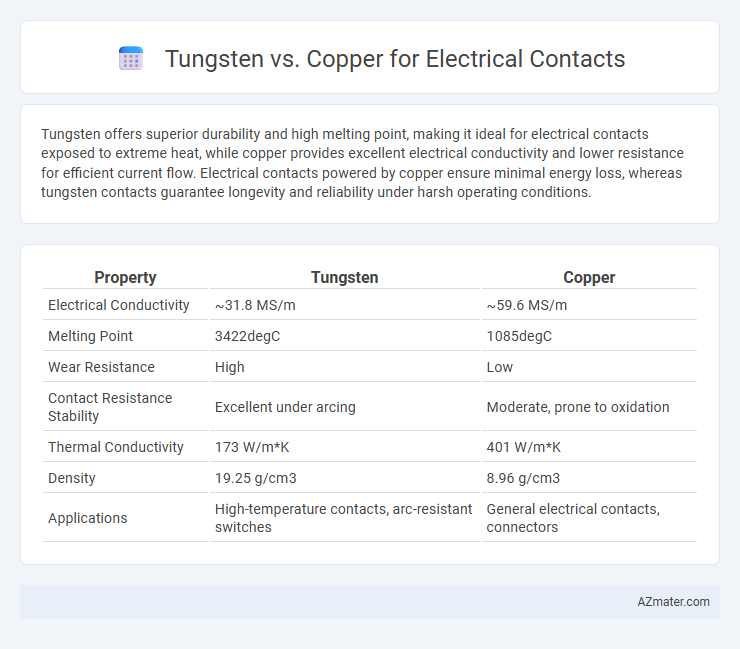Tungsten offers superior durability and high melting point, making it ideal for electrical contacts exposed to extreme heat, while copper provides excellent electrical conductivity and lower resistance for efficient current flow. Electrical contacts powered by copper ensure minimal energy loss, whereas tungsten contacts guarantee longevity and reliability under harsh operating conditions.
Table of Comparison
| Property | Tungsten | Copper |
|---|---|---|
| Electrical Conductivity | ~31.8 MS/m | ~59.6 MS/m |
| Melting Point | 3422degC | 1085degC |
| Wear Resistance | High | Low |
| Contact Resistance Stability | Excellent under arcing | Moderate, prone to oxidation |
| Thermal Conductivity | 173 W/m*K | 401 W/m*K |
| Density | 19.25 g/cm3 | 8.96 g/cm3 |
| Applications | High-temperature contacts, arc-resistant switches | General electrical contacts, connectors |
Introduction to Electrical Contact Materials
Electrical contact materials must exhibit excellent conductivity, wear resistance, and thermal stability to ensure reliable performance in circuits. Tungsten offers superior high-temperature endurance and hardness, making it ideal for environments with extreme thermal and mechanical stresses. Copper provides exceptional electrical and thermal conductivity, making it a preferred choice for low-resistance applications but with less durability under arcing conditions.
Properties of Tungsten for Electrical Contacts
Tungsten exhibits exceptional electrical conductivity combined with the highest melting point among metals, making it ideal for electrical contacts subjected to extreme temperatures and arcing conditions. Its superior hardness and resistance to wear and corrosion ensure long-lasting performance in high-load electrical applications. The low thermal expansion coefficient of tungsten also provides dimensional stability, enhancing reliability in precision electrical contacts.
Properties of Copper for Electrical Contacts
Copper offers excellent electrical conductivity with a high conductivity rating of approximately 58 MS/m, making it ideal for efficient current flow in electrical contacts. Its superior thermal conductivity, around 400 W/m*K, helps dissipate heat quickly, preventing overheating and ensuring contact reliability. Copper also exhibits good ductility and corrosion resistance, enabling durable and stable electrical connections under various environmental conditions.
Electrical Conductivity: Tungsten vs Copper
Copper exhibits superior electrical conductivity at approximately 5.96 x 10^7 S/m, making it the preferred choice for electrical contacts requiring minimal resistance and efficient current flow. Tungsten's electrical conductivity is significantly lower, around 1.79 x 10^7 S/m, but its high melting point and durability compensate for this in applications exposed to extreme heat or arcing. The conductivity disparity influences material selection, balancing performance needs such as conductivity against mechanical and thermal stability.
Thermal Conductivity Comparison
Tungsten exhibits a thermal conductivity of approximately 173 W/m*K, significantly lower than copper's 401 W/m*K, making copper the superior choice for efficient heat dissipation in electrical contacts. Tungsten's lower thermal conductivity results in higher localized temperatures under electrical load, which can affect contact performance and durability. Copper's exceptional ability to quickly transfer heat helps maintain stable contact resistance and extends the lifespan of electrical components.
Durability and Wear Resistance
Tungsten exhibits superior durability and wear resistance compared to copper due to its high melting point of 3422degC and exceptional hardness, making it ideal for electrical contacts in high-temperature and high-wear environments. Copper, with lower hardness and melting point (1085degC), offers excellent electrical conductivity but is more susceptible to wear and deformation under mechanical stress. Tungsten contacts maintain structural integrity and performance over longer cycles, reducing maintenance in demanding electrical applications.
Cost Implications and Availability
Tungsten offers superior durability and high melting point, making it ideal for electrical contacts in harsh environments, but it is significantly more expensive and less abundant than copper. Copper, known for its excellent electrical conductivity and widespread availability, provides a more cost-effective solution for general electrical contact applications. The cost implications favor copper due to its lower raw material and processing expenses, whereas tungsten's limited availability and production complexity drive up its price.
Application Suitability in Different Industries
Tungsten offers superior hardness, high melting point, and excellent arc resistance, making it ideal for heavy-duty electrical contacts in aerospace, military, and high-temperature industrial applications. Copper provides exceptional electrical conductivity and thermal conductivity, suitable for low-resistance electrical contacts in consumer electronics, power distribution, and telecommunications. Industries requiring durability under extreme conditions prefer tungsten, while those prioritizing efficient current flow and cost-effectiveness often choose copper.
Environmental Impact and Sustainability
Tungsten exhibits a lower environmental footprint than copper due to its higher durability and resistance to corrosion, reducing the need for frequent replacements and minimizing waste. Copper mining and processing contribute significantly to ecological degradation and water pollution, with higher energy consumption compared to tungsten extraction. Tungsten's recyclability and longer service life support sustainable electrical contacts by lowering resource depletion and operational impacts in industrial applications.
Conclusion: Choosing the Right Material for Electrical Contacts
Tungsten offers superior hardness, high melting point, and excellent resistance to wear and arc erosion, making it ideal for high-temperature and high-current electrical contacts. Copper excels in electrical conductivity and thermal management, suitable for applications demanding low resistance and efficient heat dissipation. Selecting between tungsten and copper depends on the specific requirements of electrical performance, durability, and operating environment, with tungsten favored in harsh conditions and copper preferred for optimal conductivity.

Infographic: Tungsten vs Copper for Electrical Contact
 azmater.com
azmater.com